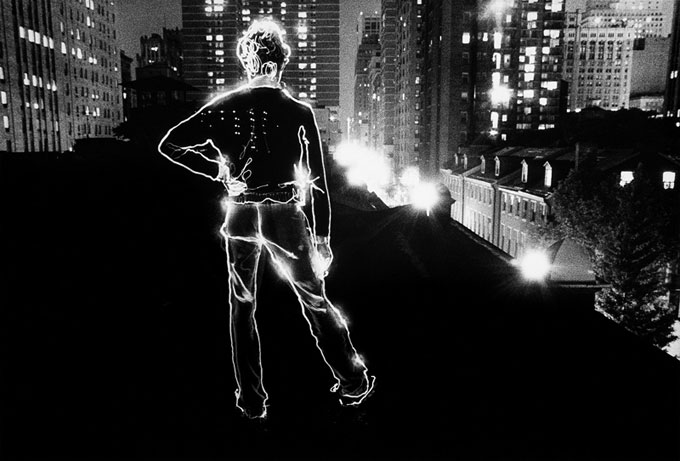Next story: Recent paintings by Hayley Carrow at Ro
Pre-Photoshop manipulated images at CEPA
by Jack Foran

Handmade Photos
One of the more eye-catching works in the current CEPA show is a complicated wall-mounted sculptural object in bright chrome metal and glass—including some tubes of reddish liquid—and mysterious photographic component—what looks like layered photo negatives maybe—entitled Untouchable Camera. So naturally I touch it, manipulate it a little. It’s on pivot hinges of some sort, so you can revolve it. But couldn’t make much sense of it. Then I looked at the materials--media--description on the handout exhibition checklist. Aluminum, titanium, copper, acrylic, and HIV-positive blood. Yikes. This is supposed to be a photography exhibit, and I’m playing with HIV-positive blood. No gloves even. Hermetically sealed in the glass tubes, I hope. But still. I look for a lavatory, and go in and wash my hands. Soap and hot water.
Well, not exactly a photography exhibit. Or photography the way we may usually think of photography. The exhibit is called Transformational Imagemaking: Handmade Photography since 1960. It was created and curated by photographic arts scholar and practitioner and former CEPA director Robert Hirsch.
Photography to start with, but not “straight” photos but altered, manipulated, collaged, appropriated, artists’ books of photos, photo-based sculptures, etc. Work that a rebel cadre of experimentalist photographers started producing in quantity in the 1960s, 1970s. Before and after Photoshop. And that photographers and critics of the “straight” school dismissed and/or abominated. Work of roughly equal elements construction and deconstruction. The rift line between the “straight” school and experimentalists turns out to be essentially the rift line between modern and post-modern.
It’s a gargantuan show, multiple works by about fifty different artists, and an accompanying book by Hirsch with excellent introductory/expository text and separate sections on each of the displayed artists, including interviews with the artists—or relevant others—about their work.
Included are classic works of the altered photo genre, such as Duane Michals’ succinct little tragic drama about the ineluctable in five sequential moments, called Death Comes to the Old Lady; Jerry Uelsmann’s famous tree and hanging roots levitating above a water body that reflects the levitation item once as a kind of marshland island, once as a kind of giant pea pod, while another, smaller version of the tree and roots floats off in the sky in the distance; and John Wood’s My Lai Massacre, in six parts, one a newspaper halftone photo of a confusion of dead Vietnamese—women and children mostly, it looks like—on a roadway, the other five parts progressively greater and greater enlargements of smaller and smaller portions of the picture, so as quickly resolving into dots, abstract splotches of black and white, making the picture unrecognizable, making it disappear. These are all from the late 1960s.
And more recent work, sometimes equally iconic, such as Joel-Peter Witkin’s macable horrific mélange of a decrepit condition artist at his easel and choice of two possible models, a live nude pseudo-seductress type and painted religious visionary type, with angel, entitled Poussin in Hell; and a piece by Tatana Kellner, who created the unforgettable Requiem for September 11 installation at CEPA one year after the destruction of the towers, composed of two lines of transparent hanging banners with photos, if available, and précis epitaphs of each of the victims of the disaster.
Some of the less compelling work raises—in spades—the critical question of intentionality. What does the intention of the artist—versus, basically, execution of the work—matter in determining artistic quality of the work? But still larger issues seem to be at stake, as Hirsch expounds in his introductory pages.
Post-mechanical-process handwork in the making of photographs, he contends, unleashes the full aesthetic potentiality of the medium, for artist and audience alike. “Instead of taking pictures that attempt to document and imitate outer reality,” he writes, “these artists make pictures that intentionally reveal their inner thought processes about making, which in turn broadens the way we look at and comprehend photographic objects…These anti-authoritarian makers tangibly visualize their own narratives/life experiences that combine their inner feelings with external events...” If the resultant work is characterized by an “expressive imprecision,” as he describes it, a positive effect of the character is that “hand-manipulated work insists that viewers invest the time to examine a newly articulated form of realism, a quintessential American hybrid that offers physical, pictorial engagement based on emotional and gestural freedom and lack of certitude.”
The Transformational Imagemaking exhibit continues through November 23. P.S. Want to see more of this sort of work, also of the highest quality? Stop in at the Nina Freudenheim Gallery display of handmade photographic works by artist Jane Hammond.
blog comments powered by Disqus|
Issue Navigation> Issue Index > v13n40 (Week of Thursday, October 2) > Art Scene > Pre-Photoshop manipulated images at CEPA This Week's Issue • Artvoice Daily • Artvoice TV • Events Calendar • Classifieds |









 Current Issue
Current Issue